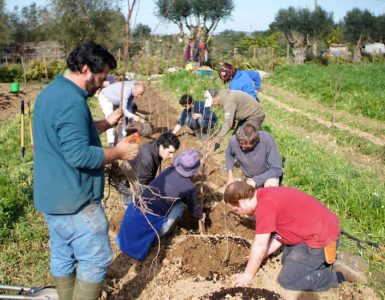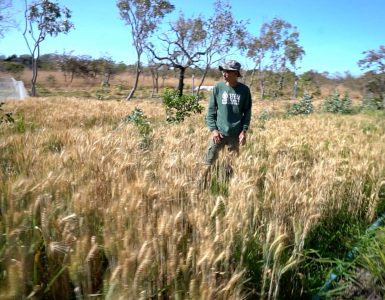In this video, Ernst shows us the strategy of the ecosystem to allow forest regeneration despite all efforts we do to prevent it. The thorny species are normally considered farmer enemies, but here they show they are perfect allies to help trees grow back again.
We need a "bee project", not a "sheep or goat project"
Many places on earth share the common threat of desertification. According to a United Nations report, the world loses 12 million hectares per year to degradation, turning what once was good soil into deserts.
We are taught in schools that most deserts present on the planet today are naturally formed. Recent studies contradict this assumption and urge that we should take responsibility for the crescent rate of degraded land that we humans create as a result of our activities.
In the book “Dirt: The Erosion of Civilizations”, the geomorphologist David Montgomery presents proofs of that. Since the Neolithic revolution, when human started manipulating nature more intensively, and above all, started farming, we see a pattern of ecosystem decay in every corner of the planet. Despite all perceived evolution of humankind, we are still repeating the same steps ancient civilizations took to turn their land into sterile deserts.
First things first, let’s give some context. The modern version of men, Homo sapiens sapiens, emerged around 35.000 years ago, in the middle of an ice age. In that period, we had fewer forests and glacial steppes were a common landscape in most places in the northern hemisphere. Although we are taught to believe that the planet was an inhospitable environment, some studies show that we lived pretty well in that period, and we were also 10 cm taller than today, with stronger teeth and bones, and less genetic problems. Well, between 13.000 and 11.000 years ago the planet warmed up, the forests advanced over grasslands and became a dominant landscape. According to Ernst’s interpretation, the climate shift affected how humans relate to nature. In our memory, we lived in open areas and couldn’t deal with the new condition: forest, which became the natural manifestation of most ecosystems in this current interglacial period.
Instead of adapting to this new environment, we decided to recreate our original condition, and that pattern repeated in most places where agriculture emerged. The recipe is not complicated. First, you cut down all the forest cover to grow grains – an important practice that allowed the first settlements but also responded for major forest loss. For the past 10.000 years, farming has become nothing but an attempt to keep squeezing the last drop of fertility of the soil, moving the ecosystems farther away to its natural condition.
The Mediterranean zone is a well-known example. Once described as the “Garden of Eden”, the region between the rivers Tiger and Euphrates have become deserts thanks to our behavior. Quoting Montgomery, it’s hard to imagine that Northern Africa was once the granary of the ancient world. Civilizations fought for millennia to control of the fertile soils of Carthage (actual Tunisia). Centuries of intense cultivation of grains and olives for export stripped down the topsoil, leading to desertification and land abandonment by the time the Vandals took Carthage from the Romans in AD 439. The presence of nomadic herds of sheep prevented rebuilding the soil, and the place turned into a desert. In that case, not a climate shift, but human interaction. If we as Homo sapiens sapiens were smart enough to learn from the evident mistakes from the past, we would do things very differently. But we are not.
“Agriculture expanded so much under the later Roman occupation that the empire’s Middle East provinces were completely deforested by the first century AD. Grazing typically replaced forests on terrain too steep to farm. Throughout the region, flocks of goats and sheep reduced vegetation to stubble. Catastrophic soil erosion followed when too many livestock grazed steep hillsides. Forest soils built up over millennia disappeared. Once the soil was gone, so was the forest”, says Montgomery.
We as Life in Syntropy are now living in a zone that is one step away to become a desert, in the south of Portugal. Looking out the window of our temporary home we see a common and apparently prosaic scene every morning. Dozens of sheep grazing the recently sprouted vegetation that grows in the slopes after the autumn rain. They eat the ecosystem attempts of regeneration. All weeds and tree seedlings that are trying to improve the place are just removed before fulfilling their tasks. No wonder there is more erosion, less rain and almost zero organic matter in the soil.
According to the classification of Syntropic Agriculture, these sites are in an evident phase of Accumulation, in which the system tends to absorb carbon in compounds more lignified. The timing is not suitable for large animals. There is still no food for them, no reserves of the ecosystem to take the next successional step. But nature is never standing or complaining. It tries, despite all our misbehavior, to reach its balance. The strategy used to deal with this situation is exemplified in the video. All we need to do is to syntropically read the environment and to participate in the regeneration process with our tools, our agriculture and our technology. We need to allow the forest to grow in order to pass the Accumulation phase and enter in the Abundance stage (or Outflow stage). At this moment, the ratio between carbon and nitrogen becomes narrower enough to perform faster transformations. That dynamics make phosphorus available and trigger water circulation. As a consequence, the fertility increases and the system provides everything large animals (including us) need to survive.







Hello Felipe,
I was reading your post. I just want to point out one thing, which I find not very accurate. You have mentioned that ancient civilizations farming has lead to soil degradation.
Although, lots of ancient civilizations had a lifestyle of living in harmony with nature. And its only the modern civilization, after industrial revolution that human started destroying nature at large scale. Never before in history of manking that such degradation of land has taken place.
As an example, native American lived in complete harmony with nature and many others like indian sub continent had great understanding of natural life.
So saying ancient civilization has destroyed nature is not right. It is for the most part moder civilization after industrial revolution had destroyed nature.
Hi Varinder, thanks for your comment. It is certainly a generalization. I agree with you and many peoples around the world managed to live in harmony with their ecosystems. In general, though, we talk about dominant models of farming which indeed caused the “erosion of civilizations”, a cycle of degradation shared by humans in different locations and periods, being the Sumerians, Egypt, Roman empire, the Greek, etc. Despite of specific good practices, the dominant models since the first settlements of farmers in ancient Europe (which used slash and burn as a farming technique for millennia until there was no more forest to cut down) caused an overall exhaustion of resources. The evidences Montgomery presents in his book give us new elements to reinterpret the history of farming which makes us wonder that our impacts on nature has been much more profound and older than we used to believe. Thanks again for your consideration! Felipe
Prezado Felipe, é sempre um prazer e uma inspiração ler os textos de vocês e assistir os vídeos com o Ernst. Costumava dizer que não posso mudar o Brasil, mas posso manter minha mesa de trabalho arrumada. O novo governo começa seu mandato em janeiro. Estamos em épocas de mudanças. Há uma animosidade patente entre os grandes e os pequenos agricultores, não só pelo forte viés ideológico e político que dominou este cenário nos últimos anos, mas, principalmente, pelo enorme desconhecimento de que existem alternativas sustentáveis e economicamente viáveis para os modelos atuais de produção! Vocês já estão fazendo este trabalho, como pudemos constatar nos vídeos sobre os milhões de hectares cultivados no Centro-Oeste, já utilizando a sintropia como doutrina. Que tal tentar levar esta idéia a nível federal? Como estão os planos neste sentido? Terei conhecimento no mais alto escalão do governo e gostaria de, pelo menos, tentar ajudar a levar a voz de vocês aos ouvidos da nova equipe do Executivo, se é que vocês já não estão lá! Se o caminho já estiver traçado, continuem contando comigo e que Deus esteja com vocês! Grande abraço! Antonio de Maricá.
Bom dia Campos, feliz 2019. Sim, a voz do life em sintropia vai atingir pessoas de grande influencia do governo um dia. Basta a gente ajudar a proliferar a ideia, pois cada dia que passa o site aqui fica mais apresentavel e organizado trazendo credibilidade para trabalhos fora do padrao de agricultura que sao praticados pelo mundo e registrados pelo Felipe e toda a equipe. Alias, voce tambem faz parte do time e nem sabe. Seu apoio ja é muito importante. Talvez seja possivel acelerar esse processo se muitas pessoas mandarem emails de forma organizada para os governantes. Em Portugal, o governo da cidade de Mertola ja se posiciona e vai sair na frente no sentido economico provavelmente. Cada um tem um objetivo, mas todos sabemos que o sentido economico domina, entao o que voce puder fazer para incentivar dentro e fora do seu alcance, ajuda bastante. O que pode fazer tambem é mandar um email para a equipe do novo governo e mostrar que essas praticas de agricultura sintropica precisam ser avaliadas melhor pelos tomadores de decisao. Aqui no Brasil todos temos medo de plantar arvores nativas, pois perdemos nosso direito de utilizar a gleba depois para fins lucrativos. É a dificuldade que estou enfrentando pelo menos. Ninguem deixa eu querer plantar arvores nativa no meio da minha produçao, pois é um risco grande de perder a gleba. Eu enviei dois emails em 2018. Um para o presidente eleito e um para a ministra da agricultura escolhida. Ambos os emails eram de deputados federais ano passado. Esse ano ja devem se encontrar em novos emails. Estamos todos no caminho certo, mas sempre tem mais espaco para pessoas como voce que querem ajudar a proliferar essa ideia. Mande emails para eles tambem e peça para eles conhecerem a agricultura sintropica. Faça experiencia propria com alguma área que voce tenha ou saiba de alguem que tenha. Registre os bons resultados. Compartilhe suas dificuldades. Se tudo ocorrer de forma positiva, com o tempo iremos superar as questoes e os desafios que nossa legislacao traz. Irá nos ajudar a incentivar atividades desse tipo por aqui, tanto na questao ambiental por causa das nativas quanto na questao trabalhista por causa das dificuldades burocraticas de contratar prestadores de servico sem violar o estatuto da terra. Quem sabe ate a questao de reforma agraria seria solucionada nos lugares mais remotos e desertos do nosso imenso Brasil. Tudo de bom pra voce! Obrigado pela iniciativa.
Estamos a um pequeno passo de dar uma guinada nesse processo de destruição que vem ocorrendo por milênios. Excelente artigo, Felipe. Pretendo esse ano fazer um tour por Universidades brasileiras e divulgar o Life in Syntropy e CEPEAS. Vamos despertar o sentido da maravilha em nossos estudantes, com certeza. Nossos experimentos com grãos estão cada vez mais avançados. Agradecemos você e Dayana por indicarem a Carolina para fazer o doutorado aqui no CEPEAS. Ela tentou em duas Universidades brasileiras, mas não entenderam a importância da agricultura sintrópica para o momento atual. Foi aceita para apresentar o projeto para Universidade de Lancaster da Inglaterra. Grande abraço !
Fernando